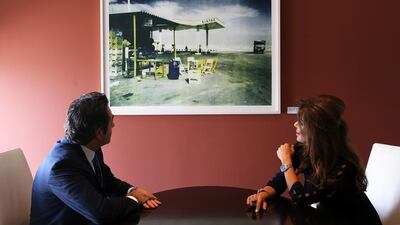Art and the corporate world go hand in hand, led by many of the world’s wealthiest banks, in a bid to reflect their taste and philanthropic leanings through their collections. And while the art scene in the UAE is still verging on the embryonic, some local businesses are already showing off their artistic licence.
Private Swiss bank Julius Baer, which has an office in Dubai International Financial Centre, has collected art – mostly contemporary and by Swiss artists – since the 1930s.
It is deliberately accessible to all employees, displayed in meeting rooms, offices, canteens, foyers and corridors. “At Julius Baer, art is not purchased for the sake of investment or prestige,” says the bank’s art curator Barbara Staubli. “Artworks are part of our corporate culture and everyday life.
“Art in the workplace opens up new horizons, motivates us to see things from a different perspective and is often a good starting point for an exchange of views.”
In Dubai, there are 47 pieces of art on display in both meeting rooms and general employee areas, including a series of five works by Mai-Thu Perret, a Swiss artist of Franco-Vietnamese origin, and a lithograph by Shirana Shahbazi, an Iranian-born photographer who lives in Switzerland.
Banks are not the only large-scale collectors. Microsoft has been curating a 5,000-strong art collection since 1987 which, it proudly proclaims on its website, reflects its “standards of innovation and creativity”, “humanises and energises the work environment” and “represents the diverse and global community of Microsoft employees and our customers”.
Norway’s Statoil displays art on its oil rigs, Penguin Books has a 200-strong collection of limited-edition British prints that it bought for £200,000 (Dh1 million), and French food company Norac Group became a big collector when France began to allow tax deductions for corporate philanthropy in 2005.
Here in Dubai, Elie Khouri, the Lebanese chief executive for Omnicom Media Group in the region, is an ardent collector, with 200-plus contemporary art and design objects in his stockpile. They include very different works by British sculptor Sir Anthony Cragg, French street artist Thierry Noir, Lebanese painter Ayman Baalbaki and Chinese artist Yue Minjun.
“Collecting art is truly a passion for me,” Mr Khouri says. “I don’t see it as a financial investment; rather, an investment in creativity, visual pleasure, intellect and emotional well-being.”
He says filling common areas with art “triggers moments of reflection, conversation and appreciation” for Omnicom’s staff.
“Study after study has confirmed what we’ve experienced first-hand at Omnicom: art in the workplace has a direct correlation with employee satisfaction, lowered levels of stress, increased morale and developing a culture of openness,” he says.
Real estate development company Emaar also invests in art. It commissions bespoke works for its commercial buildings and hotels; 1,000 for Burj Khalifa alone, featuring Emirati and regional artists, as well as World Voices, an installation by Spanish artist and sculptor Jaume Plensa, made up of 196 cymbals to represent the 196 countries of the world.
“The arts define the soul of our developments,” a spokesman says, adding that they bring “an unmatched cultural dimension” to Emaar’s properties. “Emaar’s approach to the arts is led by the fundamental belief that art enriches our lives.”
So what inspired the trend?
The first corporate collector is thought to have been a Renaissance bank called Monte dei Paschi, in 1472. But the trend really took off in the 1960s and ‘70s, led by David Rockefeller as president of Chase Manhattan Bank. Deutsche Bank has the largest corporate art collection in the world, with 57,000 pieces including Gerhard Richter’s Abstract Painting (Faust), which hangs in the lobby on Wall Street.
By the mid-’90s, according to Peter Harris and Shirley Reiff Howarth, who compiled a coffee table book called A Celebration of Corporate Art Collections Worldwide two years ago, half the Fortune 500 companies and another 2,000 in the US and Europe were actively collecting art.
The art scene itself is a work in progress in the UAE. Art Dubai, now running for 10 years, has been joined by The World Art Fair, Sikka emerging art fair and Street Art Dubai, while the Sharjah Art Foundation has its roots in the Sharjah Biennial art exposition, established in 1993 and last held in 2015. The Louvre on Saadiyat Island in Abu Dhabi is expected to finally open this year, with the Guggenheim expected to follow in 2017.
“The UAE art scene has certainly come a long way in the recent past,” says Mr Khouri. “The art on display at DIFC and Al Quoz has been getting increasingly sophisticated. Still there’s plenty of room for growth.”
business@thenational.ae

